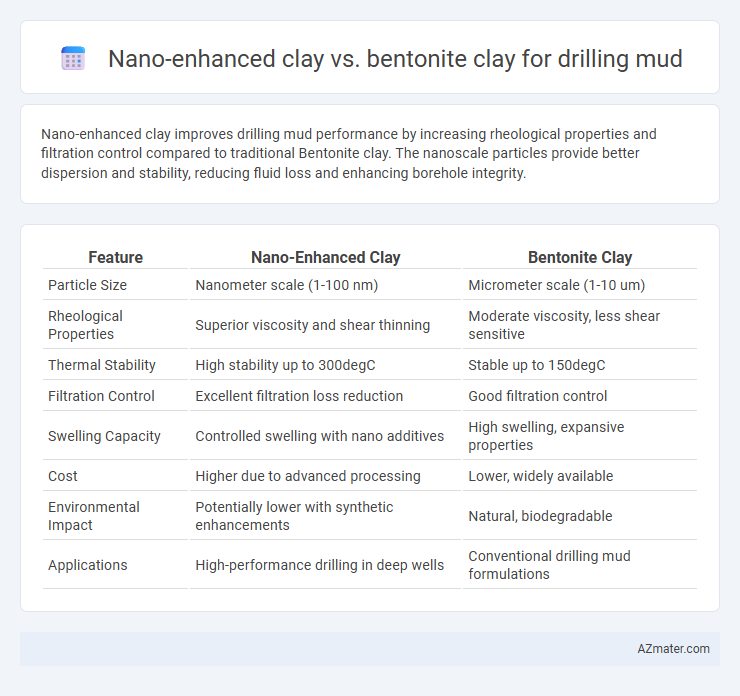Nano-enhanced clay improves drilling mud performance by increasing rheological properties and filtration control compared to traditional Bentonite clay. The nanoscale particles provide better dispersion and stability, reducing fluid loss and enhancing borehole integrity.
Table of Comparison
| Feature | Nano-Enhanced Clay | Bentonite Clay |
|---|---|---|
| Particle Size | Nanometer scale (1-100 nm) | Micrometer scale (1-10 um) |
| Rheological Properties | Superior viscosity and shear thinning | Moderate viscosity, less shear sensitive |
| Thermal Stability | High stability up to 300degC | Stable up to 150degC |
| Filtration Control | Excellent filtration loss reduction | Good filtration control |
| Swelling Capacity | Controlled swelling with nano additives | High swelling, expansive properties |
| Cost | Higher due to advanced processing | Lower, widely available |
| Environmental Impact | Potentially lower with synthetic enhancements | Natural, biodegradable |
| Applications | High-performance drilling in deep wells | Conventional drilling mud formulations |
Introduction to Drilling Muds: Essential Functions
Drilling muds perform crucial functions such as lubricating the drill bit, stabilizing the borehole, and carrying drill cuttings to the surface. Nano-enhanced clay improves the rheological properties and thermal stability of drilling muds compared to traditional bentonite clay, leading to better hole cleaning and reduced fluid loss. Enhanced particle dispersion in nano-clays contributes to increased mud viscosity and improved shale inhibition, optimizing drilling efficiency.
Overview of Bentonite Clay in Drilling Applications
Bentonite clay is widely utilized in drilling mud formulations due to its exceptional swelling properties and thixotropic behavior, which improve borehole stability and cuttings suspension. Its high cation exchange capacity enhances water retention and viscosity control, crucial for efficient drilling operations. Compared to nano-enhanced clay, bentonite offers cost-effective, natural availability with proven performance in sealing and lubricating during drilling processes.
The Rise of Nano-enhanced Clays in Drilling Technology
Nano-enhanced clays exhibit superior rheological properties and thermal stability compared to traditional Bentonite clay, making them increasingly favored in drilling mud formulations. The nano-sized particles enhance viscosity control and filtration reduction, improving borehole stability and drilling efficiency. Innovations in nanotechnology drive the adoption of these advanced clays, transforming conventional drilling practices and reducing operational costs.
Comparative Particle Structure: Nano-enhanced vs Bentonite Clays
Nano-enhanced clay exhibits significantly smaller and more uniform nanoparticles compared to the larger, plate-like particles in bentonite clay, resulting in a higher surface area and improved interaction with drilling fluids. This refined particle structure enhances rheological properties, viscosity control, and filter cake reduction, which are critical for efficient drilling mud performance. Bentonite clay's typical montmorillonite layers offer good swelling capacity, but nano-enhancement optimizes these intrinsic properties by increasing particle dispersion and stability within the mud system.
Rheological Properties: Flow and Viscosity Analysis
Nano-enhanced clay exhibits superior rheological properties compared to bentonite clay in drilling mud applications, demonstrating improved flow behavior and higher viscosity stability under varying shear rates and temperatures. The incorporation of nanoparticles refines the clay's microstructure, leading to enhanced yield stress and better suspension of cuttings, which optimizes drilling efficiency. Experimental studies reveal that nano-enhanced clay-based mud maintains consistent viscosity and superior gel strength, reducing fluid loss and enhancing wellbore stability relative to traditional bentonite formulations.
Filtration Control: Fluid Loss Reduction Efficiency
Nano-enhanced clay demonstrates superior filtration control in drilling mud by significantly reducing fluid loss compared to conventional bentonite clay. The nanoscale particles create a denser, more impermeable filter cake that enhances the sealing capability, minimizing invasion into the formation. This improved fluid loss reduction efficiency leads to better wellbore stability and reduced drilling complications.
Environmental and Economic Considerations
Nano-enhanced clay offers superior rheological properties and reduced fluid loss compared to conventional bentonite clay, enhancing drilling efficiency and minimizing environmental contamination risks associated with toxic additives. Bentonite clay remains cost-effective and widely available, but its higher water absorption and lower thermal stability often lead to increased mud volumes and disposal challenges, raising environmental and economic burdens. Implementing nano-enhanced formulations can lower overall operational costs by reducing mud consumption and waste, while promoting sustainable drilling practices through improved environmental compliance.
Wellbore Stability: Performance Under High Pressures
Nano-enhanced clay exhibits superior wellbore stability compared to traditional bentonite clay under high-pressure conditions due to its enhanced particle dispersion and reduced permeability, which minimizes fluid invasion and borehole collapse. The nanoscale additives improve the clay's rheological properties, leading to better cuttings suspension and viscosity control essential for maintaining the integrity of the wellbore. Bentonite clay, while effective, often faces challenges in extreme pressures where its swelling capacity and sealing efficiency may diminish, making nano-enhanced clays a preferred choice for advanced drilling mud formulations.
Case Studies: Real-world Application Results
Case studies demonstrate that nano-enhanced clay improves drilling mud performance by increasing rheological stability and reducing fluid loss compared to traditional bentonite clay. Field trials reveal enhanced wellbore stability and higher thermal resistance in high-pressure, high-temperature environments using nano-modified formulations. Data indicates nano-enhanced clay leads to cost savings by minimizing drilling downtime and optimizing mud circulation efficiency.
Future Trends in Drilling Mud Innovations
Nano-enhanced clay offers superior rheological properties and improved thermal stability compared to traditional bentonite clay, making it a promising material for next-generation drilling mud formulations. Advances in nanotechnology enable precise control over particle size and surface chemistry, which enhances mud performance in extreme downhole conditions. Future trends in drilling mud innovations emphasize the integration of nano-enhanced clays to optimize fluid loss control, environmental sustainability, and overall drilling efficiency.

Infographic: Nano-enhanced clay vs Bentonite clay for Drilling mud
 azmater.com
azmater.com